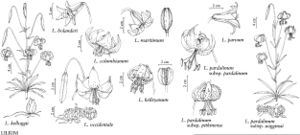Difference between revisions of "Lilium parvum"
Hesperian (San Francisco) 8: 163. 1862.
FNA>Volume Importer |
imported>Volume Importer |
||
| (5 intermediate revisions by 2 users not shown) | |||
| Line 8: | Line 8: | ||
}} | }} | ||
|common_names=Alpine lily;Sierra tiger lily | |common_names=Alpine lily;Sierra tiger lily | ||
| + | |special_status={{Treatment/ID/Special_status | ||
| + | |code=F | ||
| + | |label=Illustrated | ||
| + | }}{{Treatment/ID/Special_status | ||
| + | |code=E | ||
| + | |label=Endemic | ||
| + | }} | ||
|basionyms= | |basionyms= | ||
|synonyms={{Treatment/ID/Synonym | |synonyms={{Treatment/ID/Synonym | ||
|name=Lilium canadense var. parvum | |name=Lilium canadense var. parvum | ||
|authority=(Kellogg) Hooker | |authority=(Kellogg) Hooker | ||
| + | |rank=variety | ||
}} {{Treatment/ID/Synonym | }} {{Treatment/ID/Synonym | ||
|name=Lilium parvum var. crocatum | |name=Lilium parvum var. crocatum | ||
|authority=Stearn | |authority=Stearn | ||
| + | |rank=variety | ||
}} | }} | ||
|hierarchy=Liliaceae;Lilium;Lilium parvum | |hierarchy=Liliaceae;Lilium;Lilium parvum | ||
| Line 41: | Line 50: | ||
-->{{#Taxon: | -->{{#Taxon: | ||
name=Lilium parvum | name=Lilium parvum | ||
| − | |||
|authority=Kellogg | |authority=Kellogg | ||
|rank=species | |rank=species | ||
| Line 55: | Line 63: | ||
|publication title=Hesperian (San Francisco) | |publication title=Hesperian (San Francisco) | ||
|publication year=1862 | |publication year=1862 | ||
| − | |special status= | + | |special status=Illustrated;Endemic |
| − | |source xml=https:// | + | |source xml=https://bitbucket.org/aafc-mbb/fna-data-curation/src/2e0870ddd59836b60bcf96646a41e87ea5a5943a/coarse_grained_fna_xml/V26/V26_318.xml |
|genus=Lilium | |genus=Lilium | ||
|species=Lilium parvum | |species=Lilium parvum | ||
Latest revision as of 21:14, 5 November 2020
Bulbs rhizomatous, unbranched, continuously scaly, 1.4–3.5 × 3.3–9.2 cm, 0.3–0.5 times taller than long; scales (1–)2–3(–4)-segmented, longest 1.1–3.4 cm; stem roots absent. Stems to 1.7 m. Buds rounded in cross section. Leaves in 2–5 whorls or partial whorls, 3–13 leaves per whorl, ± horizontal and drooping at tips or ascending in sun, 4–15.1 × 0.5–4.4 cm, 2.3–10.8 times longer than wide; blade ± elliptic, margins not undulate, apex acute, often narrowly so; veins and margins ± smooth abaxially. Inflorescences racemose, 1–26(–41)-flowered. Flowers ± horizontal to ascending, sometimes slightly bilaterally symmetric, not fragrant; perianth ± funnelform; sepals and petals somewhat recurved 3/5–2/3 along length from base, not strongly reflexed, lower often less recurved than upper and forming landing platform, orange or yellowish proximally, darker (light orange, orange, red-orange, red, or rarely ± pinkish) on distal 2/5, occasionally uniformly light orange or rarely yellow, spotted dark purple-brown or maroon, often pale abaxially, not distinctly clawed; sepals not ridged abaxially, noticeably wider than petals, 3.2–4.2 × 0.8–1.3 cm; petals 3.2–4.2 × 0.6–1.2 cm; stamens moderately exserted; filaments moderately spreading, diverging 8°–17° from axis; anthers pale yellow, orangish, or magenta, 0.3–0.8 cm; pollen yellowish to red-orange; pistil 2.3–3.7 cm; ovary 0.8–1.4 cm; style pale green; pedicel 3.5–15.5 cm. Capsules 1.6–2.7 × 1.2–1.8 cm, 1.2–1.9 times longer than wide. Seeds 90–132. 2n = 24.
Phenology: Flowering summer (mid Jun–Aug).
Habitat: Wet meadows, willow (Salix spp.) thickets, and streams in coniferous forests
Elevation: 1400–2900 m
Discussion
At the lower elevations within its range, Lilium parvum tends to have clear yellow-orange flowers—a form that has been recognized as L. parvum var. crocatum—but perianth parts are redder apically at higher elevations in the Sierra Nevada. The pink-flowered form that is apparently localized at lower elevations in El Dorado County, California, is referred to informally as the ditch lily (O. H. Ballantyne 1983).
Lilium parvum hybridizes sporadically with L. pardalinum subsp. pardalinum at middle elevations (ca. 1200–1500 m) in the Sierra Nevada, resulting in variable swarms of plants with flowers that are intermediate in orientation, size, and perianth recurvature. Hybrids with Lilium kelleyanum are discussed under that species.
Lilium parvum is a pollination generalist visited by several species of hummingbirds (family Trochilidae), western tiger swallowtails (Papilio rutulus Lucas, family Papilionidae), pale swallowtails (P. eurymedon Lucas), and various bees (mostly family Apidae).
Selected References
None.

